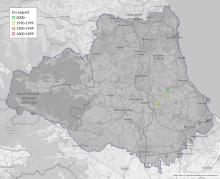Scythris picaepennis

Species account (old)
This is a rare, retiring species which was not mentioned by Robson. So far found only in old magnesian limestone quarries where Lotus corniculatus and Thymus drucei abound on the covering of humus that has accumulated on the surface of the bare rock. It is by sweeping these patches of flowers that this moth can be obtained in substantial numbers. So far only discovered in two such quarries in 1991, but it is certain to occur in others not yet tested.
Statistics
| Records | 4 |
|---|---|
| Individuals | 9 |
| Largest Sample | 5 |
| First Recorded | 1990 |
| Last Recorded | 2019 |
| Earliest Adult Record | 10/07 |
| Latest Adult Record | 13/07 |
| Monad Coverage | 0.1% |
| Hexad Coverage | 2.4% |

Map
This map shows all records of Scythris picaepennis in the Durham (VC66) database per monad (1km grid square). The map can be explored further by zooming and panning, can be reset using the button on the left, and can be filtered by selecting the era. Click on a monad to view a full list of species recorded in it, or its containing hexad (10km grid square).

Week graph
This graph shows the County Durham (VC66) records of Scythris picaepennis per 7-day period, differentiated by life stage. Hover over/tap the graph to see an exact count of records at that point in time. Hover over/hold the life stage legend to highlight a particular life stage; click on a life stage label to remove it from the graph. The graph can be filtered further by selecting the era.
The graphs below show the total records and individuals of Scythris picaepennis in County Durham (VC66) per time period. Hover over/tap the graph to see an exact number of records and individuals at a particular point in time. Hover over/hold a label to highlight a particular metric; click on a metric label to remove it from the graph.
Era graph
Year graph

Gallery
There are no photos of Scythris picaepennis on the website. If you would like to contribute any photographs please email admin@durhammoths.org.

Foodplants
This is a list of foodplants known to be used by the larval stages of Scythris picaepennis in the UK.
Habitats
There are no habitats listed for Scythris picaepennis.
Foodplant information derived from Padovani, R.; Ward, L.; Smith, R.M.; Pocock, M.J.O.; Roy, D.B. (2020). Insect species richness for each plant species and insect-plant interactions from the Database of Insects and their Food Plants [DBIF] version 2. NERC Environmental Information Data Centre. https://doi.org/10.5285/33a825f3-27cb-4b39-b59c-0f8182e8e2e4
